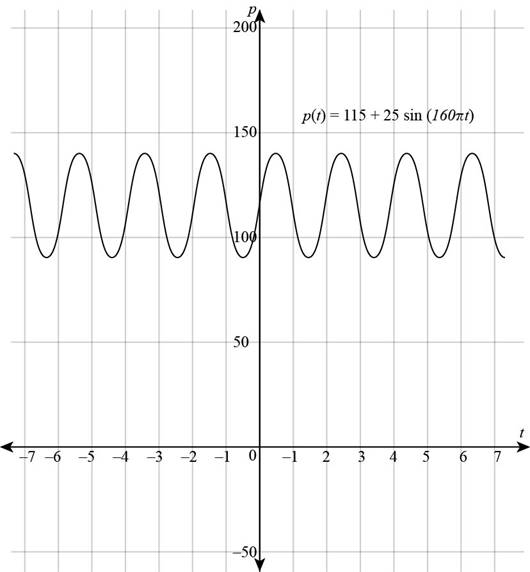
Concept explainers
Blood Pressure Each time your heart beats, your blood pressure increases, then decreases as the heart rests between beats. A certain person’s blood pressure is modeled by the function
where p(t) is the pressure (in mmHg) at time t, measured in minutes.
- (a) Find the amplitude, period, and frequency of p.
- (b) Sketch a graph of p.
- (c) If a person is exercising, his or her heart beats faster. How does this affect the period and frequency of p?
(a)
The value of amplitude, period and frequency of p for the given function.
Answer to Problem 29E
The value of amplitude for the equation
Explanation of Solution
Given:
The function which gives the blood pressure of a certain person at time t in minutes is
Calculation:
The general form of the sine function representing harmonic motion is shown below.
Where,
a is amplitude.
b is the average oscillation of an object.
c represents the position of an object at
The given function is shown below.
Compare the equation (1) and equation (2), then the value of a is 25, the value of
The formula to obtain time period p taken by an object to complete one cycle is shown below.
Substitute
Reciprocate the time period to find the value of frequency as shown below,
Substitute
Therefore, the value of amplitude is 25, the value of time period is
(b)
To sketch: The graph for the given function.
Explanation of Solution
The given function is shown below.
The representation of the function

Figure (1)
Therefore, the graph of the function
(c)
The effect on period and frequency when the heart of a man beats faster while exercising.
Explanation of Solution
A person’s heart beat increases while exercising implies that the frequency is increasing.
Time period is reciprocal of frequency therefore, whenever frequency increases time period decreases.
Thus, the frequency increases and time period decreases as a person exercises.
Chapter 5 Solutions
Precalculus: Mathematics for Calculus - 6th Edition
- Good Day, Kindly assist me with the following query. Any assistance would be appreciated.arrow_forwardCan u give rough map of any room u can choose cm on toparrow_forward3. We'd like to know the first time when the population reaches 7000 people. First, graph the function from part (a) on your calculator or Desmos. In the same window, graph the line y = 7000. Notice that you will need to adjust your window so that you can see values as big as 7000! Investigate the intersection of the two graphs. (This video shows you how to find the intersection on your calculator, or in Desmos just hover the cursor over the point.) At what value t> 0 does the line intersect with your exponential function? Round your answer to two decimal places. (You don't need to show work for this part.) (2 points)arrow_forward
- Suppose the planet of Tattooine currently has a population of 6500 people and an annual growth rate of 0.35%. Use this information for all the problems below. 1. Find an exponential function f(t) that gives the population of Tattooine t years from now. (3 points)arrow_forwardA house was valued at $95,000 in the year 1988. The value appreciated to $170,000 by the year 2007. A) If the value is growing exponentially, what was the annual growth rate between 1988 and 2007? Round the growth rate to 4 decimal places. r = B) What is the correct answer to part A written in percentage form? r = 3 %.arrow_forwardB G R + K Match each equation with a graph above - 3(0.9)* 1 a. green (G) 3(1.5)* b. black (K) 3(0.73)* c. blue (B) d. red (R) I ✪ 4(1.21)* - 3(1.21)* e. orange (O)arrow_forward
- Suppose the planet of Tattooine currently has a population of 6500 people and an annual growth rate of 0.35%. Use this information for all the problems below.arrow_forwardTwo cables tied together at C are loaded as shown. Given: Q = 130 lb. 8 30° C B Q 3 4 Draw the free-body diagram needed to determine the range of values of P for which both cables remain taut.arrow_forwardCable AB is 103 ft long and the tension in the cable is 3900 lb. 56 ft A 50° 20° B x C Identify the angles 0.0, and 8, that define the direction of force. 1 By N 2 Match each of the options above to the items below. 142.1° 57.1° 73.3° 3 8.arrow_forward
- In the given figure, P = 51 lb . 65° C 25° 35° 75 lb P Determine the corresponding magnitude of the resultant. The corresponding magnitude of the resultant is| lb.arrow_forwardCable AB is 103 ft long and the tension in the cable is 3900 lb. 56 ft D y A B 20° 50° x C Identify the x, y, and z components of the force exerted by the cable on the anchor B. 1 F. FI 3 Fy 2 Match each of the options above to the items below. 2,120 lb 1,120 lb -3,076 lbarrow_forwardIn the given figure, P = 51 lb. 65° 25° 35° 75 lb P B Determine the required tension in cable AC, knowing that the resultant of the three forces exerted at point C of boom BC must be directed along BC. The required tension in cable AC is lb.arrow_forward
 Calculus: Early TranscendentalsCalculusISBN:9781285741550Author:James StewartPublisher:Cengage Learning
Calculus: Early TranscendentalsCalculusISBN:9781285741550Author:James StewartPublisher:Cengage Learning Thomas' Calculus (14th Edition)CalculusISBN:9780134438986Author:Joel R. Hass, Christopher E. Heil, Maurice D. WeirPublisher:PEARSON
Thomas' Calculus (14th Edition)CalculusISBN:9780134438986Author:Joel R. Hass, Christopher E. Heil, Maurice D. WeirPublisher:PEARSON Calculus: Early Transcendentals (3rd Edition)CalculusISBN:9780134763644Author:William L. Briggs, Lyle Cochran, Bernard Gillett, Eric SchulzPublisher:PEARSON
Calculus: Early Transcendentals (3rd Edition)CalculusISBN:9780134763644Author:William L. Briggs, Lyle Cochran, Bernard Gillett, Eric SchulzPublisher:PEARSON Calculus: Early TranscendentalsCalculusISBN:9781319050740Author:Jon Rogawski, Colin Adams, Robert FranzosaPublisher:W. H. Freeman
Calculus: Early TranscendentalsCalculusISBN:9781319050740Author:Jon Rogawski, Colin Adams, Robert FranzosaPublisher:W. H. Freeman
 Calculus: Early Transcendental FunctionsCalculusISBN:9781337552516Author:Ron Larson, Bruce H. EdwardsPublisher:Cengage Learning
Calculus: Early Transcendental FunctionsCalculusISBN:9781337552516Author:Ron Larson, Bruce H. EdwardsPublisher:Cengage Learning





